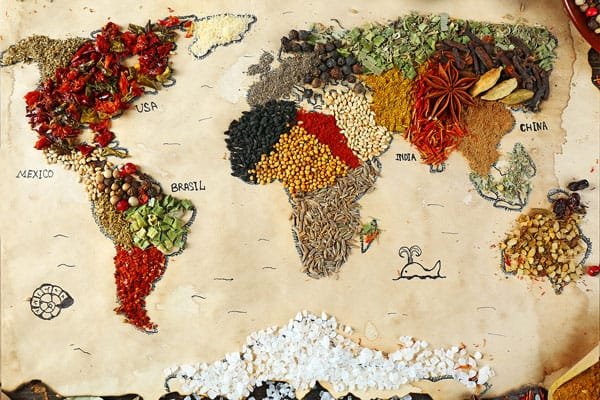
The history of curry is a fascinating journey through time, cultures, and cuisines. This versatile and beloved dish has a rich and diverse history that spans centuries and continents. In this exploration of the history of curry, we will delve into its origins, evolution, cultural significance, regional variations, and its global appeal.
You might like: 5 interesting facts about Momos
1. Origins of Curry
The history of curry can be traced back to the Indian subcontinent, where the use of spices in cooking dates back thousands of years. Spices like cardamom, black pepper, and coriander were not only used for flavor but also for their medicinal properties. The Silk Road, a network of trade routes connecting the East and West, played a crucial role in the spread of spices and culinary knowledge.
In ancient India, curry was known as “kari” or “karil,” which referred to a spiced sauce or gravy. The use of spices and herbs in cooking was deeply ingrained in Indian cuisine, and different regions developed their unique styles of curry. The concept of curry was versatile, with recipes varying from vegetarian to meat-based, and it often depended on locally available ingredients.
2. The Influence of Invasions
Throughout history, India experienced numerous invasions and migrations, including those by the Persians, Greeks, and Arabs. These interactions led to the exchange of culinary techniques and the incorporation of new ingredients. Curry, with its adaptability, absorbed foreign influences, resulting in a diverse range of flavors and styles.
The British colonization of India during the 18th and 19th centuries had a profound impact on the global spread of curry. British soldiers and officials stationed in India developed a taste for Indian cuisine, including curry dishes. As they returned to England, they brought curry recipes with them, leading to the emergence of “Anglo-Indian” curry.
3. Curry in Southeast Asia
In Southeast Asia, particularly Thailand, Malaysia, and Indonesia, curry took on a unique identity. Local ingredients like coconut milk, lemongrass, and shrimp paste were incorporated into curry recipes, creating distinct regional variations. Thai green curry, Malaysian rendang, and Indonesian rendang are some examples of these vibrant and flavorful dishes.
4. Curry in the Caribbean
Curry made its way to the Caribbean through the transatlantic slave trade and indentured labor migration. Indian laborers brought their culinary traditions, including curry, to countries like Trinidad and Guyana. Over time, Caribbean curry developed its own distinct style, often featuring goat, chicken, or seafood.
5. Curry Goes Global
In the 20th century, curry became a global phenomenon. It found its way into kitchens and restaurants around the world, adapting to local tastes and ingredients. From Japanese curry to South African bunny chow, curry became a beloved dish in diverse cultures. This chapter examines the global appeal and adaptation of curry.

Today, curry is a culinary icon celebrated for its complexity of flavors, versatility, and ability to bring people together. It has evolved from its humble origins in India to become a beloved dish enjoyed by millions worldwide. Whether served in a traditional Indian restaurant or a modern fusion eatery, curry continues to be a symbol of culinary innovation and cultural diversity.
Recipe of curry
Certainly! Curry is a broad term used to describe a variety of dishes with a sauce or gravy typically served with rice or bread. It’s a versatile and flavorful dish that can be made in countless ways. Here’s a basic recipe for a delicious vegetable curry:
Ingredients:
For the Curry Base:
- 2 tablespoons vegetable oil
- 1 large onion, finely chopped
- 2 cloves garlic, minced
- 1-inch piece of ginger, grated
- 2 tomatoes, chopped
- 1 teaspoon cumin seeds
- 1 teaspoon coriander powder
- 1/2 teaspoon turmeric powder
- 1/2 teaspoon chili powder (adjust to taste)
- Salt to taste
For the Vegetables:
- 2 cups mixed vegetables (e.g., carrots, peas, potatoes, bell peppers, cauliflower), chopped into bite-sized pieces
For the Sauce:
- 1 can (14 oz) of coconut milk
- 1/2 cup water (adjust for desired consistency)
- 1/2 teaspoon garam masala
- Fresh cilantro leaves for garnish (optional)
Instructions:
- Prepare the Vegetables: Wash, peel (if necessary), and chop the mixed vegetables into bite-sized pieces. You can use a combination of your favorite vegetables.
- Make the Curry Base:
- Heat the vegetable oil in a large, deep pan or pot over medium heat.
- Add the cumin seeds and let them sizzle for a few seconds until fragrant.
- Add the chopped onions and sauté until they become soft and translucent.
- Stir in the minced garlic and grated ginger. Sauté for another minute or until the raw smell disappears.
- Add the chopped tomatoes, coriander powder, turmeric powder, chili powder, and salt. Cook until the tomatoes become soft and the oil starts to separate from the mixture.
- Cook the Vegetables:
- Add the chopped mixed vegetables to the spice and tomato mixture. Stir well to coat the vegetables with the spices.
- Cook for 5-7 minutes, stirring occasionally, until the vegetables begin to soften.
- Add the Sauce:
- Pour in the can of coconut milk and half a cup of water. Stir to combine all the ingredients.
- Cover the pot and let the curry simmer on low heat for about 15-20 minutes, or until the vegetables are tender. Stir occasionally to prevent sticking.
- Season and Garnish:
- Season the curry with garam masala, which adds a final layer of flavor. Adjust the seasoning with salt and chili powder if needed.
- Garnish with fresh cilantro leaves for a burst of freshness and color.
- Serve:
- Serve the vegetable curry hot with steamed rice or your choice of bread, such as naan or roti.
Feel free to customize this basic vegetable curry recipe by adding protein sources like tofu, paneer, chicken, or shrimp if desired. Additionally, you can experiment with various spices and herbs to suit your taste preferences. Enjoy your homemade curry!



